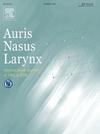Health-related lifestyle behaviors in patients with vestibular migraine and migraine only: A cross-sectional comparative study
IF 1.5
4区 医学
Q2 OTORHINOLARYNGOLOGY
引用次数: 0
Abstract
Objective
There is an increasing interest in lifestyle modification in the disease management of patients with vestibular migraine (VM) and migraine only (MO) without vertiginous complaints. The primary aim of this study was to compare health-related lifestyle factors, including sedentary behavior, sleep quality, mood, and nutrition habits, between patients with VM, MO, and healthy controls (HCs). The secondary aim was to explore the association between health-related lifestyle factors and disability status in VM and MO groups.
Methods
This cross-sectional case-control study included 21 patients with VM, 30 patients with MO, and 33 HCs. Vertigo and headache severity caused by migraine-triggering foods with Numeric Rating Scale-NRS, disability status with Migraine Disability Assessment-MIDAS, sedentary behavior with Sedentary Behavior Questionnaire-SBQ, sleep quality with Pittsburgh Sleep Quality Index-PSQI and mood with Hospital Anxiety and Depression Scale-HADS were recorded in 3 groups.
Results
While the exercising, smoking, SBQ, PSQI, HADS-anxiety, and HADS-depression were similar for patients with VM and MO, a higher rate of alcohol consumption was found for patients with VM compared to the MO group (p < 0.05). The VM and MO groups demonstrated significant correlations between the headache severity caused by migraine-triggering foods and disability status (p < 0.05).
Conclusion
Adapting new lifestyle interventions and dietary counseling should be encouraged to improve the disease management of patients with VM and MO.
前庭偏头痛和单纯偏头痛患者与健康相关的生活方式行为:一项横断面比较研究
目的:对前庭偏头痛(VM)和单纯偏头痛(MO)患者的疾病管理中生活方式改变的兴趣越来越大。本研究的主要目的是比较VM、MO和健康对照(hc)患者之间与健康相关的生活方式因素,包括久坐行为、睡眠质量、情绪和营养习惯。第二个目的是探讨VM和MO组中与健康相关的生活方式因素与残疾状况之间的关系。方法:本横断面病例对照研究包括21例VM患者,30例MO患者和33例hc患者。采用数值评定量表(nrs)、残疾状况量表(midas)、久坐行为量表(sbq)、睡眠质量量表(psqi)和医院焦虑抑郁量表(hads)分别记录三组患者偏头痛诱发食物引起的眩晕和头痛严重程度。结果:VM和MO患者的运动、吸烟、SBQ、PSQI、hads -焦虑、hads -抑郁相似,VM患者的酒精消耗率高于MO组(p < 0.05)。VM组和MO组偏头痛食物引起的头痛严重程度与残疾状况有显著相关性(p < 0.05)。结论:应鼓励采用新的生活方式干预和饮食咨询,以改善VM和MO患者的疾病管理。
本文章由计算机程序翻译,如有差异,请以英文原文为准。
求助全文
约1分钟内获得全文
求助全文
来源期刊

Auris Nasus Larynx
医学-耳鼻喉科学
CiteScore
3.40
自引率
5.90%
发文量
169
审稿时长
30 days
期刊介绍:
The international journal Auris Nasus Larynx provides the opportunity for rapid, carefully reviewed publications concerning the fundamental and clinical aspects of otorhinolaryngology and related fields. This includes otology, neurotology, bronchoesophagology, laryngology, rhinology, allergology, head and neck medicine and oncologic surgery, maxillofacial and plastic surgery, audiology, speech science.
Original papers, short communications and original case reports can be submitted. Reviews on recent developments are invited regularly and Letters to the Editor commenting on papers or any aspect of Auris Nasus Larynx are welcomed.
Founded in 1973 and previously published by the Society for Promotion of International Otorhinolaryngology, the journal is now the official English-language journal of the Oto-Rhino-Laryngological Society of Japan, Inc. The aim of its new international Editorial Board is to make Auris Nasus Larynx an international forum for high quality research and clinical sciences.
 求助内容:
求助内容: 应助结果提醒方式:
应助结果提醒方式:


